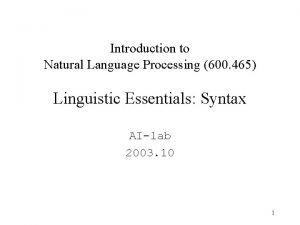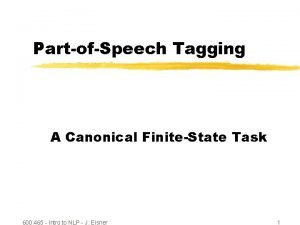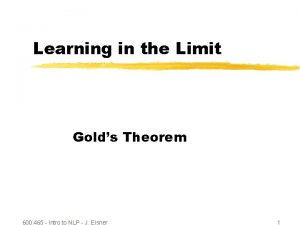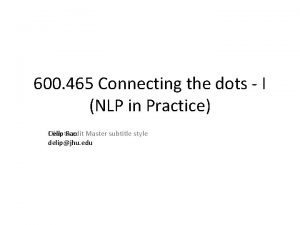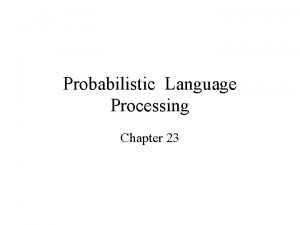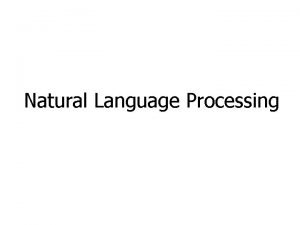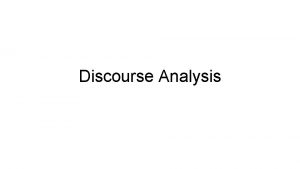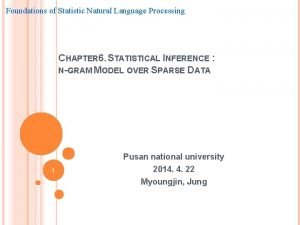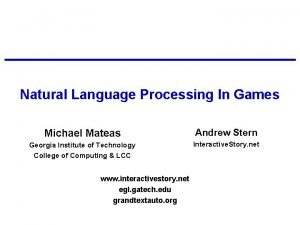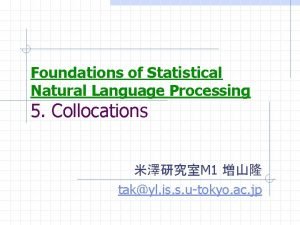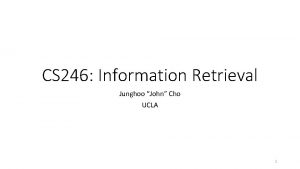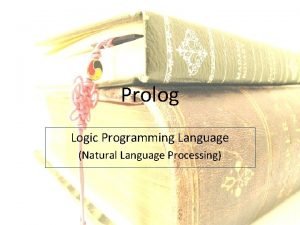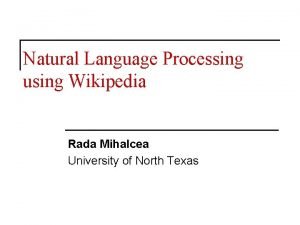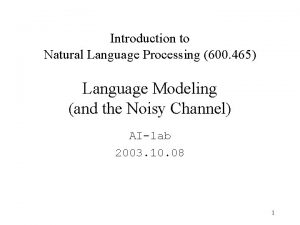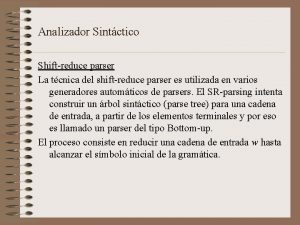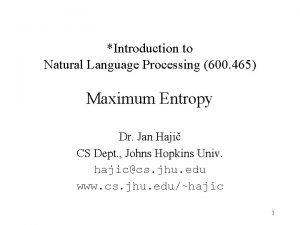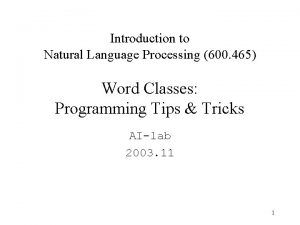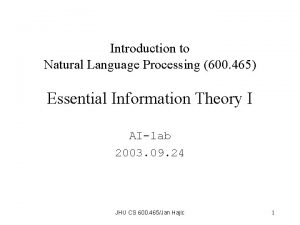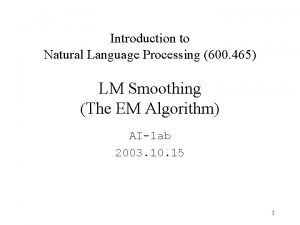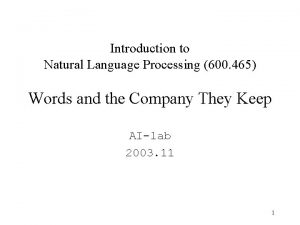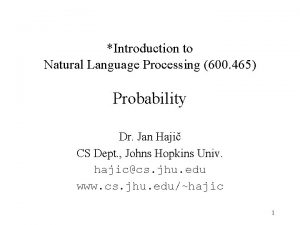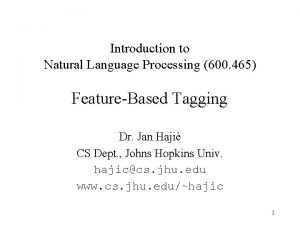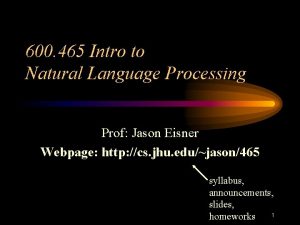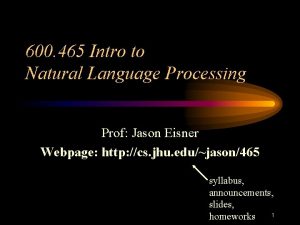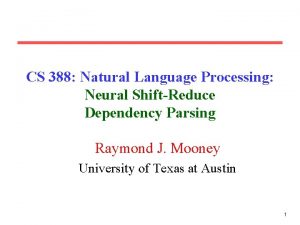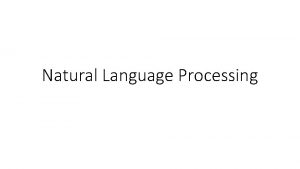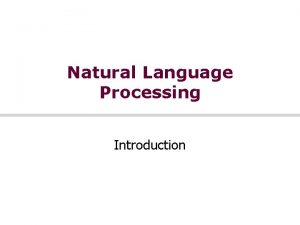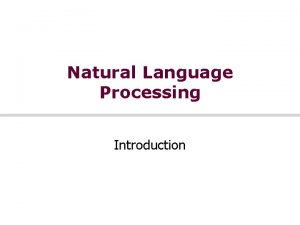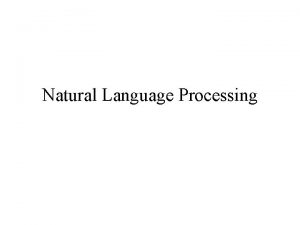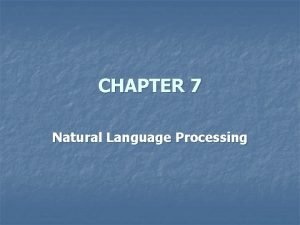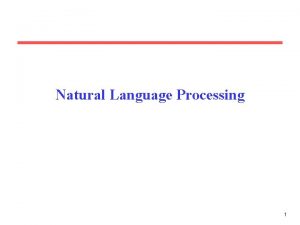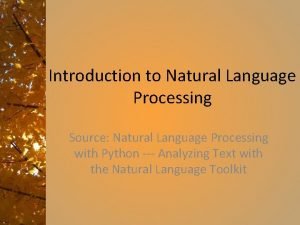Introduction to Natural Language Processing 600 465 ShiftReduce





















- Slides: 21

Introduction to Natural Language Processing (600. 465) Shift-Reduce Parsing in Detail Dr. Jan Hajič CS Dept. , Johns Hopkins Univ. hajic@cs. jhu. edu www. cs. jhu. edu/~hajic 1

Grammar Requirements • Context Free Grammar with – no empty rules (N ® e) • can always be made from a general CFG, except there might remain one rule S ® e (easy to handle separately) – recursion OK • Idea: – go bottom-up (otherwise: problems with recursion) – construct a Push-down Automaton (non-deterministic in general, PNA) – delay rule acceptance until all of (possible) rule parsed 2

PNA Construction Elementary Procedures • Initialize-Rule-In-State(q, A ® a) procedure: – Add the rule (A ® a) into a state q. – Insert a dot in front of the R[ight]H[and]S[ide]: A ®. a • Initialize-Nonterminal-In-State(q, A) procedure: – Do “Initialize-Rule-In-State(q, A ® a)” for all rules having the nonterminal A on the L[eft]H[and]S[ide] • Move-Dot-In-Rule(q, A ® a. Zb) procedure: – Create a new rule in state q: A ® a. Z. b, Z term. or not 3

PNA Construction • Put 0 into the (FIFO/LIFO) list of incomplete states, and do Initialize-Nonterminal-In-State(0, S) • Until the list of incomplete states is not empty, do: 1. Get one state, i from the list of incomplete states. 2. Expand the state: • Do recursively Initialize-Nonterminal-In-State(i, A) for all nonterminals A right after the dot in any of the rules in state i. 3. If the state matches exactly some other state already in the list of complete states, renumber all shift-references to it to the old state and discard the current state. 4

PNA Construction (Cont. ) 4. Create a set T of Shift-References (or, transition/continuation links) for the current state i {(Z, x)}: • Suppose the highest number of a state in the incomplete state list is n. • For each symbol Z (regardless if terminal or nonterminal) which appears after the dot in any rule in the current state q, do: – increase n to n+1 – add (Z, n) to T • NB: each symbol gets only one Shift-Reference, regardless of how many times (i. e. in how many rules) it appears to the right of a dot. – Add n to the list of incomplete states – Do Move-Dot-In-Rule(n, A ® a. Zb) 5. Create Reduce-References for each rule in the current state i: • For each rule of the form (A ® a. ) (i. e. dot at the end) in the current state, attach to it the rule number r of the rule A ® a from the grammar. 5

Using the PNA (Initialize) • Maintain two stacks, the input stack I and the state stack Q. • Maintain a stack B[acktracking] of the two stacks. • Initialize the I stack to the input string (of terminal symbols), so that the first symbol is on top of it. • Initialize the stack S to contain state 0. • Initialize the stack B to empty. 6

Using the PNA (Parse) • Do until you are stuck and/or B is empty: – Take the top of stack Q state (“current” state i). – Put all possible reductions in state i on stack B, including the contents of the current stacks I and Q and the rule list. – Get the symbol from the top of the stack I (symbol Z). – If (Z, x) exists in the set T associated with the current state i, push state x onto the stack S and remove Z from I. Continue from beginning. – Else pop the first possibility from the top of B, remove n symbols from the stack S, and push A to I, where A ® Z 1. . . Zn is the rule according to which you are reducing. 7

Small Example Grammar #1 S ® NP VP #2 NP ® N no ambiguity, #3 VP ® V NP no recursion #4 N ® a_cat #5 N ® a_dog #6 V ® saw Tables: <symbol> <state>: shift #<rule>: reduction 0 S ®. NP VP NP 1 NP ®. N N 2 N ®. a_cat 3 N ®. a_dog 4 NB: dotted rules in states need not be kept 1 S ® NP. VP VP ®. V NP V ®. saw 2 NP ® N. 3 N ® a_cat. 4 N ® a_dog. 5 S ® NP VP. 6 VP ® V. NP NP ®. N N ®. a_cat N ®. a_dog 7 V ® saw. 8 VP ® V NP. VP 5 V 6 saw 7 #2 #4 #5 #1 NP 8 N 2 a_cat 3 a_dog 4 #6 #3 8

Small Example: Parsing(1) • To parse: a_dog saw a_cat Input stack (top on the left) Rule State stack (top on the left) Comment(s) • a_dog saw a_cat 0 • saw a_cat 40 shift to 4 over a_dog • N saw a_cat #5 0 reduce #5: N ® a_dog • saw a_cat 20 shift to 2 over N • NP saw a_cat #2 0 reduce #2: NP ® N • saw a_cat 10 shift to 1 over NP • a_cat 710 shift to 7 over saw • V a_cat #6 10 reduce #6: V ® saw 9

Small Example: Parsing (2) • . . . still parsing: a_dog saw a_cat • [V a_cat #6 1 0] ¬ Previous parser configuration • a_cat 610 shift to 6 over V • 3 6 1 0 empty input stack (not finished though!) • N #4 610 N inserted back • 2 6 1 0. . . again empty input stack • NP #2 610 • 8 6 1 0. . . and again • VP #3 10 two states removed (|RHS(#3)|=2) • 510 • S #1 0 again, two items removed (RHS: NP VP) Success: S/0 alone in input/state stack; reverse right derivation: 1, 3, 2, 4, 6, 2, 5 10

Big Example: Ambiguous and Recursive Grammar • • #1 S ® NP VP #2 NP ® NP REL VP #3 NP ® N #4 NP ® N PP #5 VP ® V NP #6 VP ® V NP PP #7 VP ® V PP #8 PP ® PREP NP #9 N ® a_cat #10 N ® a_dog #11 N ® a_hat #12 PREP ® in #13 REL ® that #14 V ® saw #15 V ® heard 11

Big Example: Tables (1) 0 S ®. NP VP NP ®. NP REL VP NP ®. N PP N ®. a_cat N ®. a_dog N ®. a_mirror 1 S ® NP. VP NP ® NP. REL VP VP ®. V NP PP VP ®. V PP REL ®. that V ®. saw V ®. heard NP 1 N 2 a_cat 3 a_dog 4 a_hat 5 VP REL V 6 7 8 2 NP ® N. PP PP ®. PREP NP PREP ®. in #3 PP 12 PREP 13 in 14 3 N ® a_cat. #9 4 N ® a_dog. #10 5 N ® a_hat. #11 6 S ® NP VP. #1 that 9 saw 10 heard 11 12

Big Example: Tables (2) 7 NP ® NP REL. VP VP ®. V NP PP VP ®. V PP V ®. saw V ®. heard 8 VP ® V. NP PP VP ® V. PP NP ®. NP REL VP NP ®. N PP N ®. a_cat N ®. a_dog N ®. a_hat PP ®. PREP NP PREP ®. in VP V 15 8 saw 10 heard 11 NP PP N a_cat a_dog a_hat PREP in 9 REL ® that. #13 10 V ® saw. #14 11 V ® heard. #15 12 NP ® NP P. #4 13 PP ® PREP. NP NP ®. NP REL VP NP ®. N PP N ®. a_cat N ®. a_dog N ®. a_hat NP 18 N 2 16 17 2 3 4 5 13 14 a_cat 3 a_dog 4 a_hat 5 13

Big Example: Tables (3) 14 PREP ® in. #12 15 NP ® NP REL VP. #2 19 VP ® V NP PP. 16 VP ® V NP. PP NP ® NP. REL VP PP ®. PREP NP PREP ®. in REL ®. that #5 PP REL PREP in that 17 VP ® V PP. #7 18 PP ® PREP NP. NP ® NP. REL VP REL ®. that #8 REL 7 that 9 19 7 13 14 9 #6 Comments: - states 2, 16, 18 have shift-reduce conflict - no states with reduce-reduce conflict - also, again there is no need to store the dotted rules in the states for parsing. Simply store the pair input/goto-state, or the rule number. 14

Big Example: Parsing (1) • To parse: a_dog heard a_cat in a_hat • • • Input stack (top on the left) Rule a_dog heard a_cat in a_hat N heard a_cat in a_hat #10 heard a_cat in a_hat NP heard a_cat in a_hat #3 heard a_cat in a_hat V a_cat in a_hat #15 a_cat in a_hat 1 see also next slide, last comment State stack (top on the left) Backtrack Comment(s) 0 shifted to 4 over a_dog 40 shift to 4 over a_dog 0 reduce #10: N ® a_dog 20 shift to 2 over N 1 0 reduce #3: NP ® N 10 shift to 1 over NP 11 1 0 shift to 11 over heard 10 reduce #15: V ® heard 810 shift to 8 over V 15

Big Example: Parsing (2) • . . . still parsing: a_dog heard a_cat in a_hat • • Input stack (top on the left) Rule [a_cat in a_hat N in a_hat #9 in a_hat State stack (top on the left) Backtrack Comment(s) 8 1 0] ¬ [previous parser configuration] 3810 shift to 3 over a_cat 810 reduce #9: N ® a_cat 2810 Ä shift to 2 over N; see why we need the state stack? we are in 2 again, but after we return, we will be in 8 not 0; also save for backtrack 1! 1 the whole input stack, state stack, and [reversed] list of rules used for reductions so far must be saved on the backtrack stack 16

Big Example: Parsing (3) • . . . still parsing: a_dog heard a_cat in a_hat Input stack (top on the left) Rule [in a_hat PREP a_hat #12 a_hat • • • NP • #11 #3 State stack (top on the left) Backtrack Comment(s) 2 8 1 0 Ä] ¬ [previous parser configuration] 14 2 8 1 0 shift to 14 over in 2810 reduce #12: PREP ® in 1 13 2 8 1 0 shift to 13 over PREP 5 13 2 8 1 0 shift to 5 over a_hat 13 2 8 1 0 reduce #11: N ® a_hat 2 13 2 8 1 0 shift to 2 over N 13 2 8 1 0 shift not possible; reduce #3: NP ® N 1 on s. 19 18 13 2 8 1 0 shift to 18 over NP 1 when coming back to an ambiguous state [here: state 2] (after some reduction), reduction(s) are not considered; nothing put on backtrk stack 17

Big Example: Parsing (4) • . . . still parsing: a_dog heard a_cat in a_hat Input stack (top on the left) Rule • [ • PP #8 • • NP • • VP #4 #5 State stack (top on the left) Backtrack Comment(s) 18 13 2 8 1 0] ¬ [previous parser config. ] 2810 shift not possible; reduce #81 on s. 19: PP ® PREP NP 1, prev. slide 12 2 8 1 0 shift to 12 over PP 810 reduce #4: NP ® N PP 16 8 1 0 shift to 16 over NP 10 shift not possible, reduce #51: VP ® V NP 1 no need to keep the item on the backtrack stack; no shift possible now and there is only one reduction (#5) in state 16 18

Big Example: Parsing (5) • . . . still parsing: a_dog heard a_cat in a_hat Input stack (top on the left) Rule • [VP #5 • • S #1 • • in a_hat NP in a_hat #3 State stack (top on the left) Backtrack Comment(s) 1 0] ¬ [previous parser configuration] 610 shift to 6 over VP 0 reduce #1: S ® NP VP first solution found: 1, 5, 4, 8, 3, 11, 12, 9, 15, 3, 10 backtrack to previous Ä : 2810 was: shift over in, now 1: 810 reduce #3: NP ® N 16 8 1 0 Ä shift to 16 over NP 14 16 8 1 0 shift, but put on backtrk 1 no need to keep the item on the backtrack stack; no shift possible now and there is only one reduction (#3) in state 2 19

Big Example: Parsing (6) • . . . still parsing: a_dog heard a_cat in a_hat Input stack (top on the left) Rule • [a_hat • PREP a_hat #12 • a_hat • • N #11 • • NP #3 • • PP #8 • State stack (top on the left) Backtrack Comment(s) 14 16 8 1 0 Ä] ¬ [previous parser config. ] 16 8 1 0 reduce #12: PREP ® in 13 16 8 1 0 shift over PREP 1 on s. 17 5 13 16 8 1 0 shift over a_hat to 5 13 16 8 1 0 reduce #11: N ® a_hat 2 13 16 1 0 shift to 2 over N 13 16 1 0 shift not possible 1 on s. 19 18 13 16 1 0 shift to 18 16 1 0 shift not possible 1, red. #8 19 16 1 0 shift to 191 on s. 17 1 no need to keep the item on the backtrack stack; no shift possible now and there is only one reduction (#8) in state 18 20

Big Example: Parsing (7) • . . . still parsing: a_dog heard a_cat in a_hat Input stack (top on the left) Rule • [ • VP #6 • • S #1 • • in a_hat VP in a_hat S in a_hat #5 #1 1 continue list of rules at the orig. backtrack mark (s. 16, line 3) State stack (top on the left) Backtrack Comment(s) 19 16 8 1 0] ¬ [previous parser config. ] 10 red. #6: VP ® V NP PP 610 shift to 6 over VP 0 next (2 nd) solution: 1, 6, 8, 3, 11, 12, 3, 19, 15, 3, 10 backtrack to previous Ä : 16 8 1 0 was: shift over in 1 on s. 19, 10 now red. #5: VP ® V NP 610 shift to 6 over VP 0 error 2; backtrack empty: stop 2 S (the start symbol) not alone in input stack when state stack = (0) 21
 600-465
600-465 600-465
600-465 600-465
600-465 600-465
600-465 Sudut istimewa
Sudut istimewa Natural language processing vietnamese
Natural language processing vietnamese Probabilistic model natural language processing
Probabilistic model natural language processing Natural language processing nlp - theory lecture
Natural language processing nlp - theory lecture Markov chain natural language processing
Markov chain natural language processing Language
Language Contoh bahasa alami
Contoh bahasa alami Discourse analysis in nlp
Discourse analysis in nlp Nlp lecture notes
Nlp lecture notes Language
Language Natural language processing fields
Natural language processing fields Natural language processing fields
Natural language processing fields Natural language processing lecture notes
Natural language processing lecture notes Façade michael mateas
Façade michael mateas Collocation 例
Collocation 例 John cho ucla
John cho ucla Prologn
Prologn Rada mihalcea
Rada mihalcea
